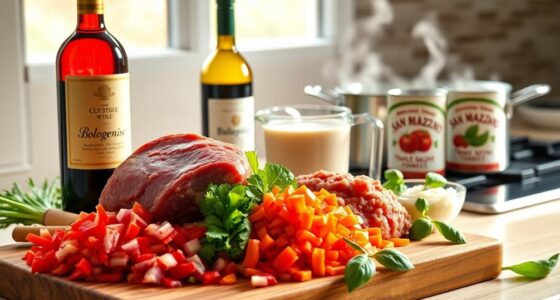Fragrant honeysuckle meat sauce combines sweet and savory flavors, enhancing your dishes with a unique twist. Made with grilled peppers, ripe tomatoes, garlic, and honeysuckle, this sauce offers a delicate balance that's perfect for pasta, dips, or grilled meats. You can customize it with herbs and spices to suit your taste, adjusting the heat as desired. You'll discover how to make this fragrant sauce and explore its culinary versatility as you continue to explore its delightful possibilities.
History

Although honeysuckle might seem like a modern addition to meat sauces, its use actually dates back centuries.
You'll find that honeysuckle has been a staple in traditional cooking, especially in Asian cuisines where its sweet and fragrant qualities elevate various dishes.
Ancient references in Chinese herbal medicine highlight honeysuckle's culinary and medicinal benefits, showcasing its longstanding role in flavoring sauces.
Many cultures associate honeysuckle with summer, a symbol of sweetness and nostalgia that influences its incorporation into savory meat sauces.
This blend of sweet and savory reflects a historical trend in global culinary traditions, celebrating the balance of flavors.
As a natural sweetener, honeysuckle enhances meat dishes, making it a cherished choice for many chefs throughout history.
Recipe
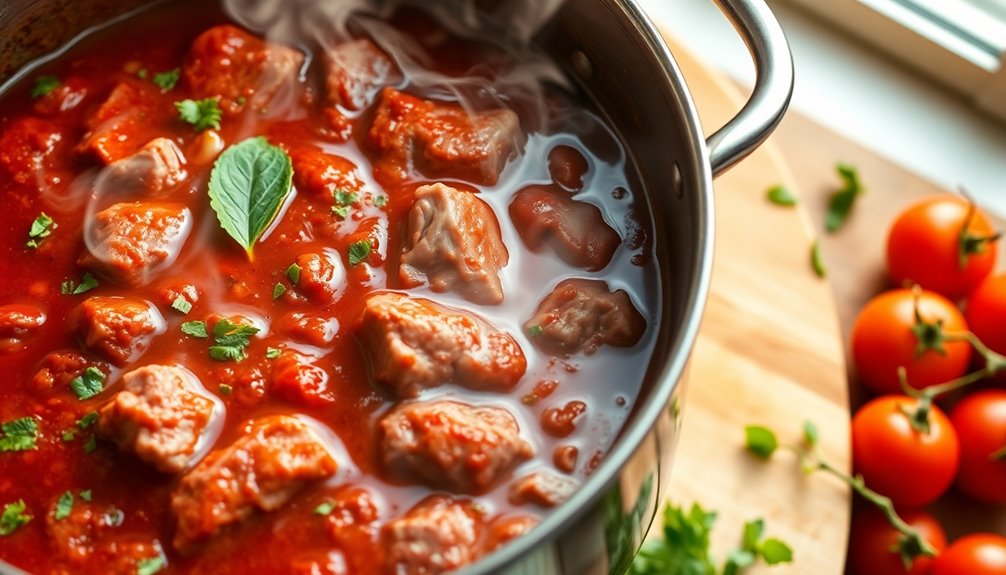
This sauce strikes a perfect balance between sweet and sour, enriched by the robust flavors of garlic and a hint of smokiness. It can be adjusted to suit your taste preferences, with the option to increase its heat by adding fresh garlic or pepper.
Whether served over pasta, paired with grilled meats and vegetables, or used as a dip for crispy bread, this fragrant honeysuckle meat sauce will elevate your meals with its rich and inviting flavors.
Ingredients
- 4 red Bulgarian peppers
- 4 ripe tomatoes
- 1/4 cup honeysuckle (fresh or juice)
- 3 cloves garlic (minced)
- 1 teaspoon smoked paprika
- 1/2 teaspoon salt
- 1/4 teaspoon black pepper
- Fresh herbs (basil or parsley) for garnish
- Olive oil (for grilling)
Cooking Instructions
Start by preheating your grill to medium-high heat. Lightly coat the red Bulgarian peppers and tomatoes with olive oil, then place them on the grill.
Grill the peppers and tomatoes until their skins are charred and blistered, about 10-15 minutes, turning occasionally. Once grilled, remove them from the heat and allow them to cool slightly.
Peel off the skins, then combine the grilled vegetables in a blender with honeysuckle, minced garlic, smoked paprika, salt, and black pepper. Blend until smooth, taste, and adjust seasoning or spiciness as desired.
Serve warm over your favorite dish or allow it to cool for a delicious dip.
Extra Tips
For an added layer of flavor, consider roasting the garlic alongside the peppers and tomatoes, which will create a sweeter, more mellow taste.
If you're looking for a thicker sauce, let it simmer on low heat for a few minutes after blending to reduce excess moisture.
This sauce can also be made in larger batches and stored in the refrigerator for up to a week or frozen for later use, making it a convenient option for quick meals.
Enjoy experimenting with different herbs and spices to personalize your honeysuckle meat sauce!
Cooking Steps

Now that you've got your ingredients ready, it's time to prepare the honeysuckle-infused marinade that'll elevate your sauce.
You'll blend the grilled peppers and honeysuckle together, then simmer the mixture until it thickens.
Finally, adding spices and fresh herbs will enhance the flavor, making your meat sauce irresistible.
Step 1. Prepare Honeysuckle-Infused Marinade
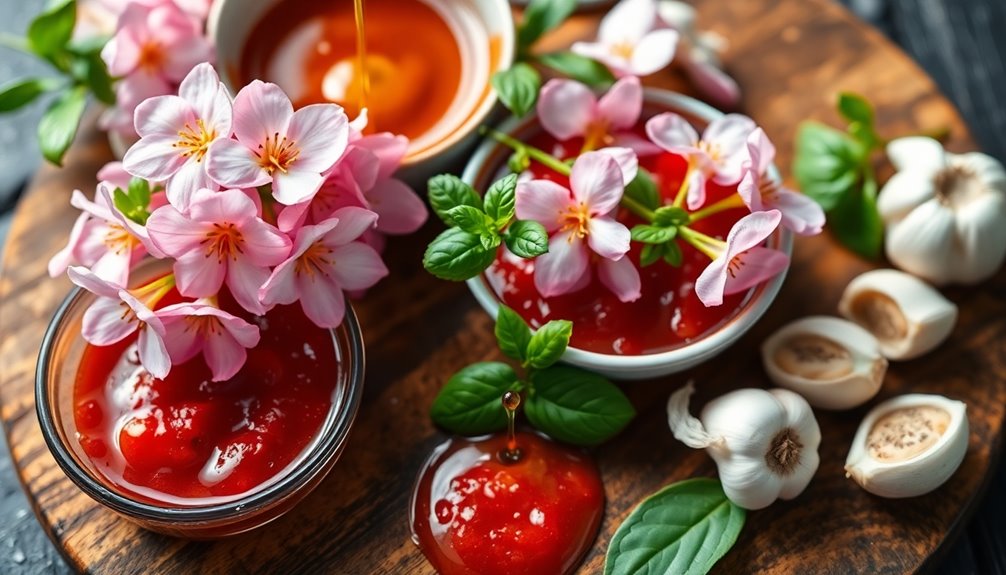
To prepare your honeysuckle-infused marinade, start by removing the seeds from 2 large red Bulgarian peppers and cutting them into quarters.
Next, prepare 2 medium tomatoes to prevent them from bursting during cooking. Grill or bake the peppers and tomatoes until they're soft, turning the peppers once while leaving the tomatoes untouched.
Once cooked, let the vegetables cool before peeling off their skins for a smoother texture. Transfer the peeled vegetables to a deep container, then add 1/3 cup of honeysuckle.
Puree the mixture until smooth. Finally, mix in your choice of spices, a splash of oil, and finely chopped fresh garlic, green onions, and dill.
Chill the marinade in the refrigerator before using it on meat or vegetables.
Step 2. Blend Peppers and Honeysuckle
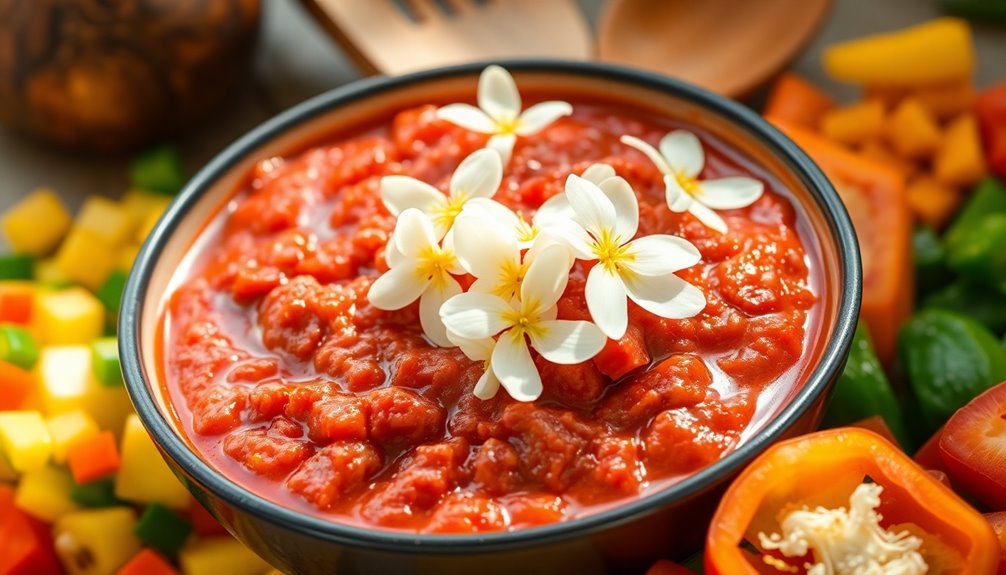
After chilling your honeysuckle-infused marinade, it's time to blend those roasted peppers and honeysuckle together for a rich, flavorful sauce.
Start by removing the seeds from the red Bulgarian peppers and cutting them into four parts. Prepare the tomatoes to prevent them from bursting during cooking. Grill or bake the peppers and tomatoes until soft, turning the peppers once while keeping the tomatoes undisturbed.
Once grilled, let the vegetables cool before peeling off their skins for a smoother texture. Transfer the peeled veggies to a deep container, add the honeysuckle, and blend until smooth.
Finally, stir in spices, oil, and finely chopped ingredients, then chill the sauce in the refrigerator to enhance the flavor. Enjoy!
Step 3. Simmer Sauce Until Thickened
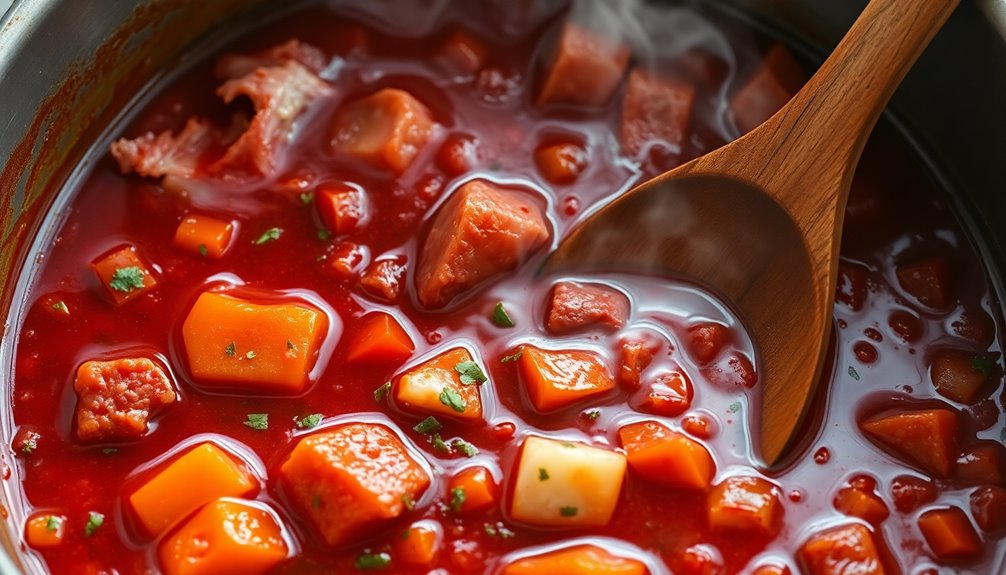
As you combine the pureed grilled vegetables and honeysuckle in a deep container, it's essential to gradually heat the mixture over low to medium heat.
Stir frequently to prevent sticking and ensure even cooking. Let the sauce simmer gently, allowing the flavors to meld and the mixture to thicken through evaporation.
Keep an eye on the sauce's consistency; you want it to become noticeably thicker and more concentrated. This process usually takes some time, but it's worth the wait as the flavors deepen.
Once the sauce reaches your desired texture, remove it from the heat. Let it cool before serving or storing, ensuring it's ready for your next delicious meal.
Enjoy the fragrant aromas that fill your kitchen!
Step 4. Add Spices to Enhance Flavor

With the sauce thickened and flavors enriched, it's time to elevate your fragrant honeysuckle meat sauce with spices.
Start by adding fresh garlic to taste, which enhances the sweet and sour notes beautifully. If you like a kick, toss in some crushed red pepper or freshly ground black pepper to adjust the heat level to your liking. Additionally, spices can enhance flavor and create a more complex profile for your dish.
For a deeper, smoky aroma, consider experimenting with smoked paprika or cumin—they pair wonderfully with grilled meats and veggies.
To add a tangy twist, a splash of vinegar or citrus juice can balance the sauce's sweetness. Additionally, incorporating essential oils such as lemon can enhance both flavor and aroma in your dish.
Step 5. Incorporate Fresh Herbs

To elevate your fragrant honeysuckle meat sauce, incorporate fresh herbs that will bring vibrancy and depth to the dish. Finely chop herbs like dill and green onion before adding them to the sauce. This ensures an even distribution and maximizes their flavor impact. Additionally, consider the benefits of hydration from fresh herbs, as they can enhance the flavor profile and balance the sweetness of the honeysuckle with savory and herbal notes for a deliciously complex sauce. Fresh herbs can also provide nutritional advantages that contribute to overall well-being.
Remember to add the herbs toward the end of the cooking process; this helps retain their freshness and aromatic qualities, keeping them potent.
You might also consider experimenting with other fresh herbs like basil or parsley to create unique variations that complement different meats and vegetables. A mix of fresh herbs can enhance the flavor profile, balancing the sweetness of the honeysuckle with savory and herbal notes for a deliciously complex sauce.
Final Thoughts
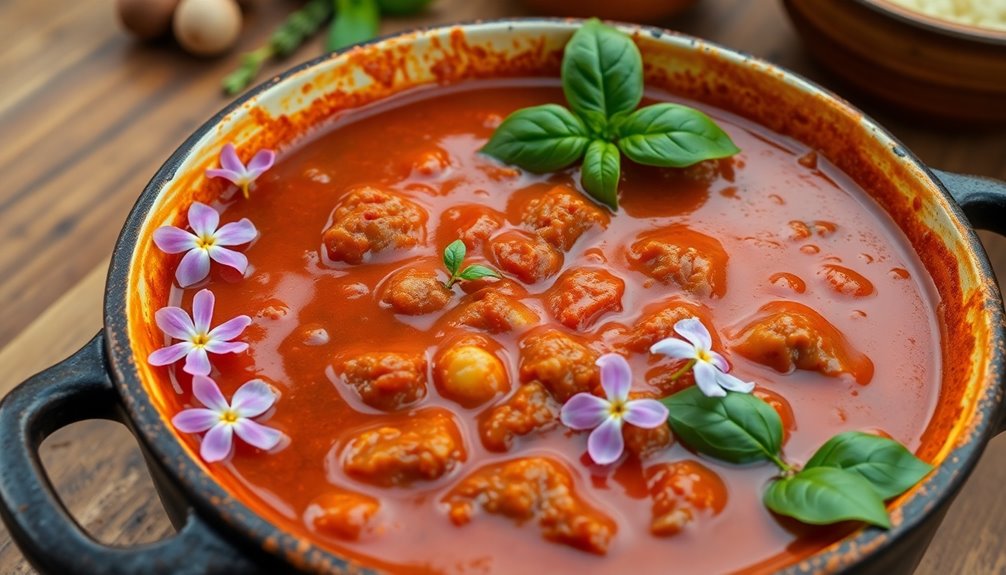
While you might've your go-to sauces, the fragrant honeysuckle meat sauce offers a unique twist that can elevate your meals.
Its delicate sweet and sour flavor, combined with the enticing aromas of garlic and smoke, makes it a standout choice for various dishes.
Whether you're drizzling it over pasta, using it as a dip for crispy bread, or pairing it with grilled meats and vegetables, this sauce adapts beautifully to your culinary needs.
Plus, you can easily adjust the spiciness to suit your taste by adding more garlic or pepper.
Remember to chill the sauce in the refrigerator before serving to enhance its flavors, making your dish even more delightful.
Enjoy experimenting with this versatile sauce!
Frequently Asked Questions
What Is the Difference Between Meat Sauce and Bolognese?
When you're comparing meat sauce to Bolognese, you'll notice key differences.
Bolognese is a specific Italian sauce that's thick, slow-cooked, and rich, often using ground meat, tomatoes, and vegetables.
Meat sauce, on the other hand, can vary widely in ingredients and consistency. It might be lighter or include different spices and herbs.
If you're looking for depth of flavor, Bolognese is your go-to, while meat sauce gives you more versatility.
What Is the One Ingredient That Makes Spaghetti Sauce so Much Better?
Oh sure, you could say spaghetti sauce is just tomatoes and mystery, but let's be real—garlic's the unsung hero here.
Toss in some fresh garlic, and suddenly, you're not just eating; you're dining! It infuses the sauce with a robust aroma that'll have you questioning every bland sauce you've ever encountered.
Sure, you could skip it, but why would you want to? Your taste buds deserve way better than that, don't they?
What Is Meat Sauce at Olive Garden?
When you think of meat sauce at Olive Garden, picture a hearty blend of ground beef and pork simmered with Italian seasonings.
It's rich and savory, perfect over pasta like spaghetti or lasagna. You'll appreciate the freshness since they make it in-house daily.
The tomato base, combined with garlic and herbs, gives it that aromatic touch.
You can even customize your meal by choosing different pasta shapes to pair with it!
What Is Meat Sauce Called in Italy?
As the saying goes, "A way to a person's heart is through their stomach."
In Italy, what you know as meat sauce is commonly called "ragù." This delicious sauce often combines ground meat, tomatoes, and aromatic vegetables.
The most famous version is "ragù alla Bolognese," originating from Bologna, where it's slow-cooked to enhance its rich flavors.
Different regions have their own variations, but all offer a comforting, hearty experience you'll love.





